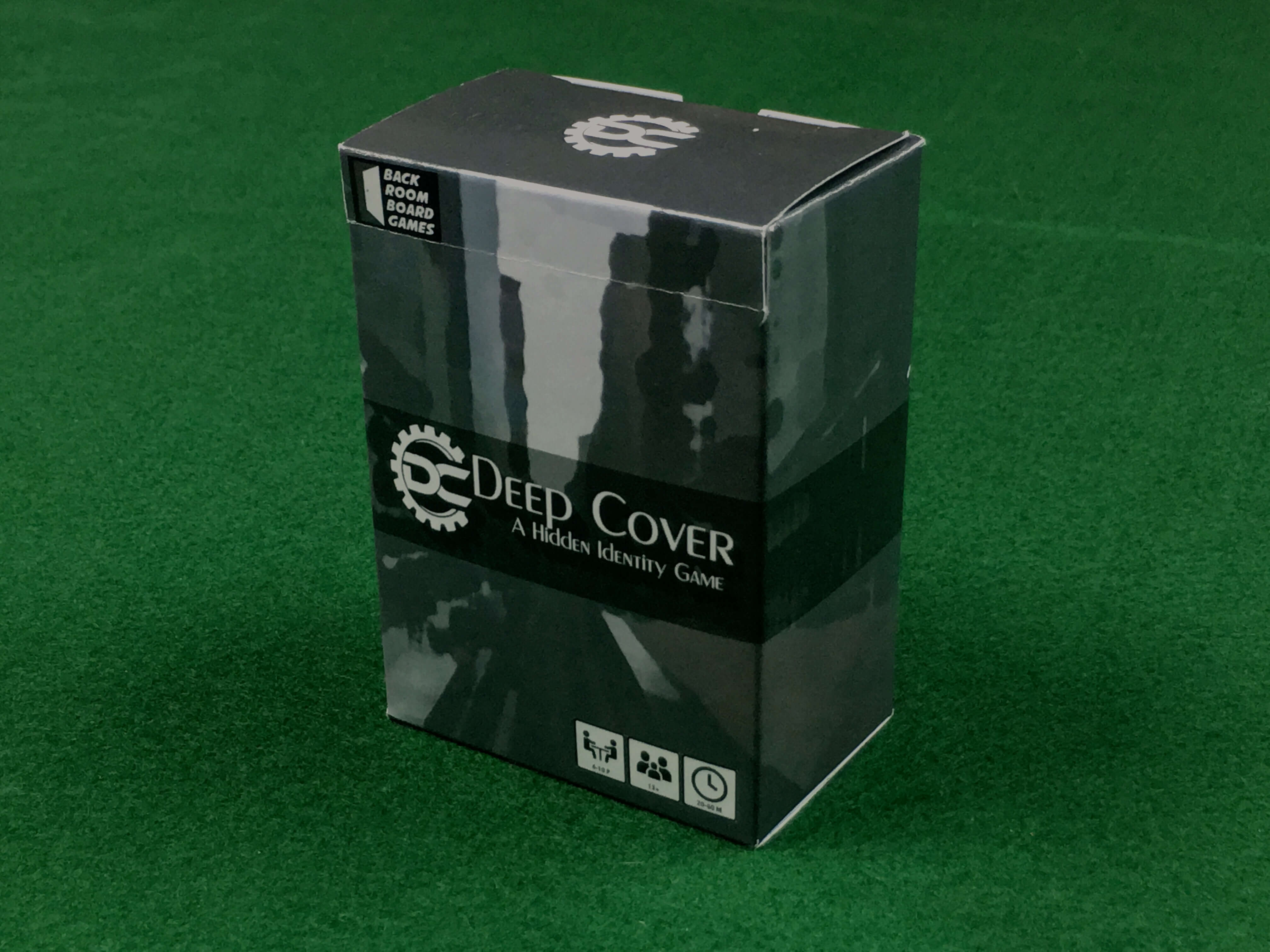
Deep Cover is a social deduction game by Back Room Board Games with two teams (Law Enforcement and Criminals) and a potential traitor on each team (a Mole on the Law Enforcement team and/or an Undercover on the Criminal team).
Each team acts as a unit, but the traitor embedded in the team may be able to undermine everyone else’s efforts. Occasionally a team may draw a card that can allow them to oust someone they think is a traitor, but they immediately lose if they oust an innocent teammate.
This is one in a series of seven articles outlining my judging decisions for the finalists in The Game Crafter‘s social deduction game design challenge. You can see the full article list here.
Visit Gamified Content’s YouTube channel to watch my review of Deep Cover’s shop page from the semi-finalist judging round.
High-Level Review
The rules for this game contradicted themselves in several places, so my table of play testers at Madison Protospiel and I were unable to play with confidence that we were doing things as intended. We went through the motions of playing a couple of rounds to see if getting the cards in hand and on the table helped make things more clear, but this ended up only serving to highlight how very confused we were.
Many people who saw the game and read the flavor text on the box said they’d love to have the experience it describes, but the lack of clarity in the rules is currently getting in the way of that experience.
Overall, this is an interesting concept in both theme and mechanics, but it needs more development work and play testing.
Components
This game comes in a 108 card poker tuck box. The outside of the box does a great job of communicating all the important stats for the game like player count and play time. There is also a company logo in place to help with brand building and recognition. The game itself has an interesting logo, a catchy name, and a good tagline that describes the experience inside.
I’m a little surprised to see that the designer chose to put their design credit on the bottom of the box under the boring legal jargon. It’s more common to see a designer’s name on the cover of a game — similar to a novel’s by-line. I don’t think there’s any placement of the designer credit that I’d label as “wrong.” Some game boxes don’t include the designers name at all. This is more of an observation of something I found interesting about the designer/publisher’s choice for their box design.
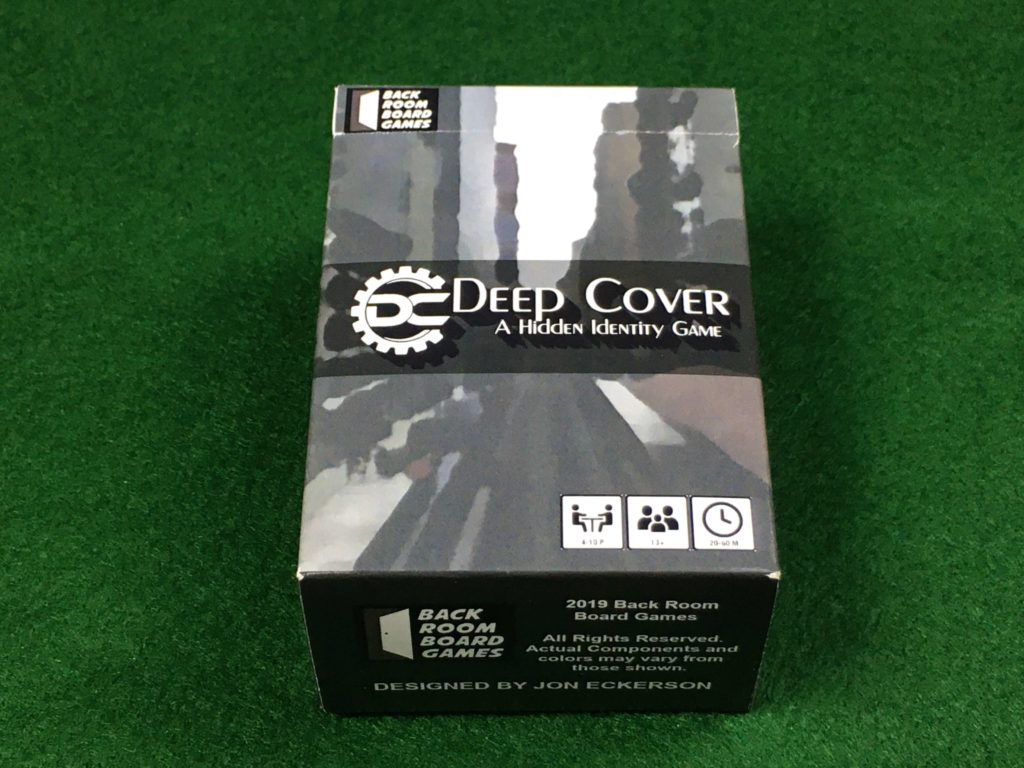
The back of the box has a well-written, evocative story to help potential players get exited about the game world and their role in it. It also does a good job of letting people know what they can expect to find inside with a card image and list of components.
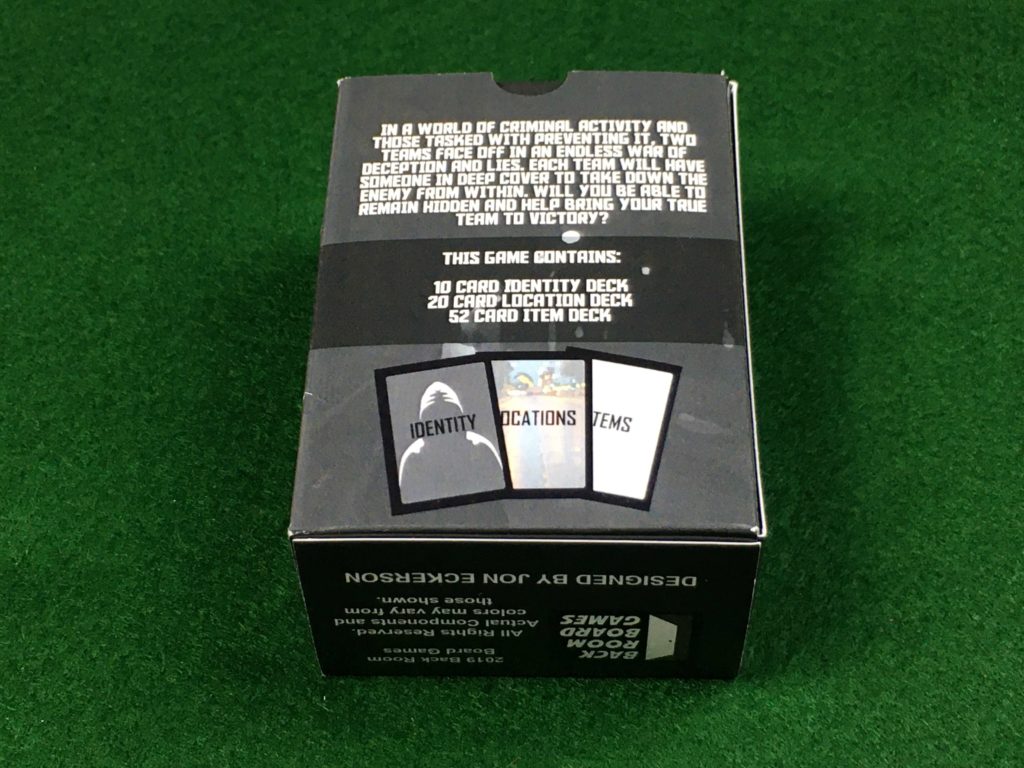
The first thing I noticed when I opened the box was that there was no rules document inside. This created some inconvenience for me because I was at a convention and didn’t have easy access to my own printer. In the end, I was lucky to be at an event hosted by The Game Crafter, and they were kindly supplying a printer along with paper and ink free of charge.
Even though the rules PDF is available for free on the game’s shop page, it’s not easy to read off of a smartphone screen when I’m out and about — and if I don’t have good service or a good charge on my phone, I might not be able to get to it at all.
In my experience participating in a lot of different types of game nights, it’s also always better to have access to a rule book that players can easily pass around. Often multiple people want a chance to read a passage for themselves.
The bottom line is, if you want to avoid making your players cranky from the moment they open your game box (and possibly end up deciding to not bother with figuring out how to play your game at all), make sure to include a printed rule book.
There were 3 types of cards in the box, and they were easy to sort based on the clear designations on their backs.
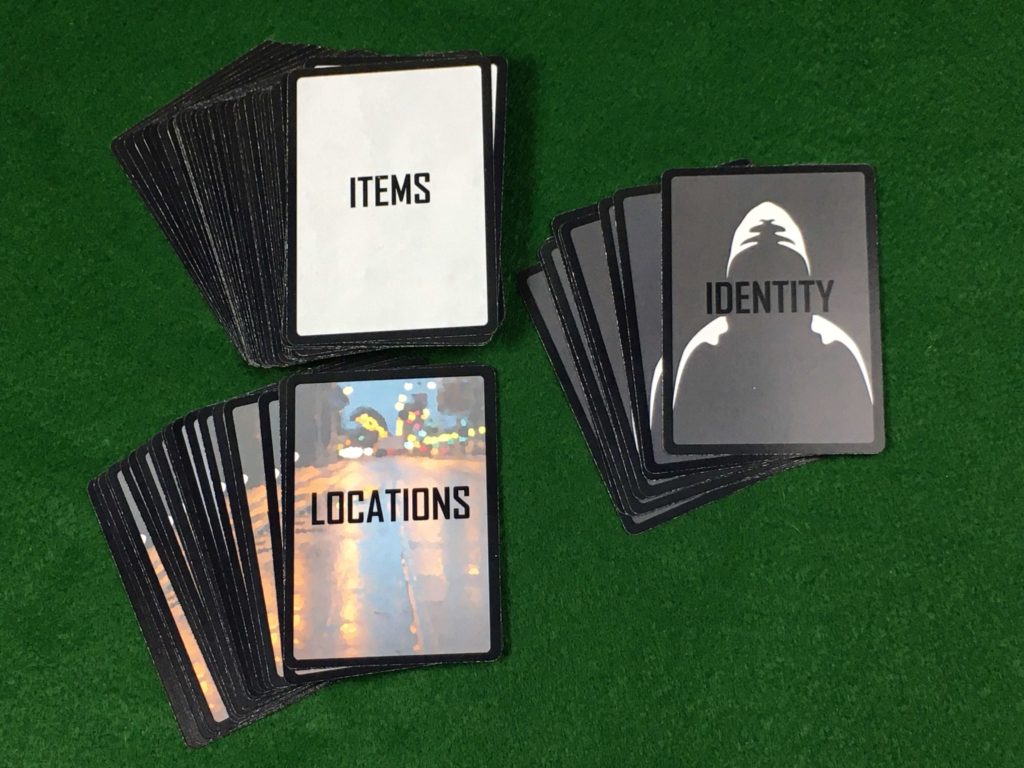
The item card deck had a total of 6 types of cards in it, which were all easy to read and identify at a glance.

The location card deck had lots of nice colorful pictures. The headings were clear and easy to read, and the icons to designate which team the cards were related to made everything easy to identify.
The text at the bottom of each card was a little bit harder to read. I think it would be an improvement to enlarge this text a couple of points.
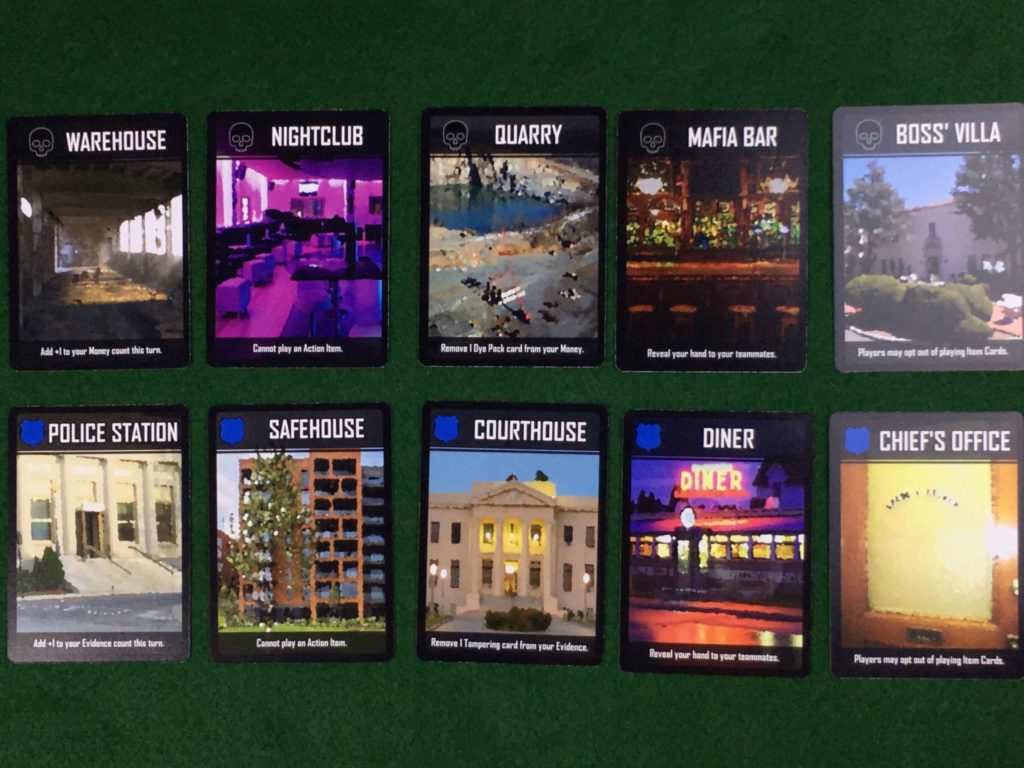
The identity card deck had large readable headings and symbols that players could easily process at a glance. The cards for the two traitor roles were unfortunately a little confusing.
In a social deduction game, it’s critical that players know exactly what they are supposed to do as soon as they look at their identity assignment card. If they seem at all hesitant or confused about their card, it will be an immediate giveaway that they are a traitor — especially in that case that all non-traitor roles have no special abilities, as is the case in Deep Cover.
One easily correctable issue with the design of these cards is that black borders show wear very easily. This can create noticeable marks on the backs of the cards that negatively affect game play. Pure white borders have a similar problem of easily getting grimy from the dirt and oil on players’ hands. Notice that classic playing cards (at least the professional ones used in poker tournaments) have full-bleed patterned backs. This is the approach I’d recommend for the border of any social deduction game’s card backs.

My suggestion for making the identity cards more instantly understandable would be to put the name of the team the player openly joins in bold letters at the top, making the icon universally match the title at the top (skull for all presenting as criminal team, badge for all law enforcement team), and adding the name of their role as a text overlay to the icon in the center. Optionally, there could be a footnote at the bottom of all cards that describes the alignment of the role — something like “the good” and “the bad.”
Game Play and Mechanics
It’s hard for me to give a really solid review of the mechanics of this game since we were not able to play it to completion. The following is my feedback based on how I’m guessing things would have worked if we had the designer teaching us how to play.
The setup for the identity cards was more convoluted than seemed necessary. I get the impression that the designer wants the game to work with any combination of cards in the identity deck for any player count. I think it would make for a better overall player experience if the makeup of the identity deck were more rigidly determined by the number of players.
I would rather play a game setup I know has been play tested and resulted in a fun experience for previous players than have a large number of possible setups without assurance that all of them are equally fun. I can’t imagine that all possible player count breakdowns would be fun. (A team of 2 with 1 traitor and 1 loyal against a team of 3 loyal, for example, does not sound fun to me.)
The main thing that caused confusion for us in the rules was whether or not we were all allowed to play any type of card no matter our role. The rules seemed to say you were only allowed to play cards that would help your true alliance, but it’s hard to imagine it ever being possible to stay hidden as a traitor if this is the case. (Especially considering there is a location that can sometimes come up and force you to show your teammates your hand before you play cards.)
The process of picking a location card was also really complex, but ultimately resulted in a random card flip. This seems to be a major place where the traitor player has a chance to sabotage their apparent team. If they play a location for the opposite side, the team matching that card would be the ones allowed to play.
The instructions say to discuss which card to flip after playing into a pile, shuffling, and laying them out on the table. Since the cards have been randomized, I don’t understand what there is to discuss. It seems like it would work just as well — and take less time — to always flip the top card after a shuffle.
The the location card action to show your teammates all the cards in your hand before playing felt overpowering to me — especially considering that it’s shuffled back into the deck every single round. To me it seems the traitors need to be able to keep their cards hidden at all times. I would recommend either getting rid of this card or replacing it with another action — maybe to show only one of your two cards to your teammates.
Another major confusion for us was which pile your cards were meant to be played in. The rules talk about playing cards to the criminal vs. the law enforcement pile, but it was unclear to us when a player should or shouldn’t play a card to the opposite team’s pile.
In general, I’m having trouble understanding why it would be good to have separate piles at all. Players get a new random hand of item cards each turn, so, if the piles are separated, and only certain kinds of cards can go in certain piles, it seems like it would be easy to end up with only one card played to a pile. This would mean all players would know for sure the card a certain player played. This feels inherently unfair and un-fun for the players in the traitor roles.
Since the whole point is for the traitors to act at cross-purposes to their teammates, they must always have access to plausible deniability. If they end up backed into a corner with no way to bluff their way out of the situation, the game has taken away all of their agency.
There are only 2 copies of the hand gun (to allow criminals to kill the undercover) and 2 copies of the handcuffs (to allow the law enforcement to arrest the mole) in the item deck. Our play group felt that this setup was clunky.
It seems simpler to get rid of these cards all together and instead allow players to call for a vote against a believed traitor at any time. This keeps these cards from clogging up your hands when you need items and allows the game to end quickly if a traitor makes a misstep. The fact that your team completely loses if you oust the wrong person seems like enough of a deterrent from making wild votes to me.
In the one round we managed to play through, the net score for both sides was 0. The end game conditions are for one team to make it to 40 points or have a confrontation with a traitor. When it’s easily possible to get 0 points per round, 40 points will make for a really time consuming game. In my opinion, this is much too time consuming for the level of player agency involved.
I would recommend making the win condition 10-15 points. This way, players can play a second and maybe even third game with new roles in the same amount of time it would have taken to play one game to 40 points.
Scoring
The following scoring breakdown is based on a rubric I released during the game design challenge on TGC’s contest page. All sections are worth a maximum of 1 point.
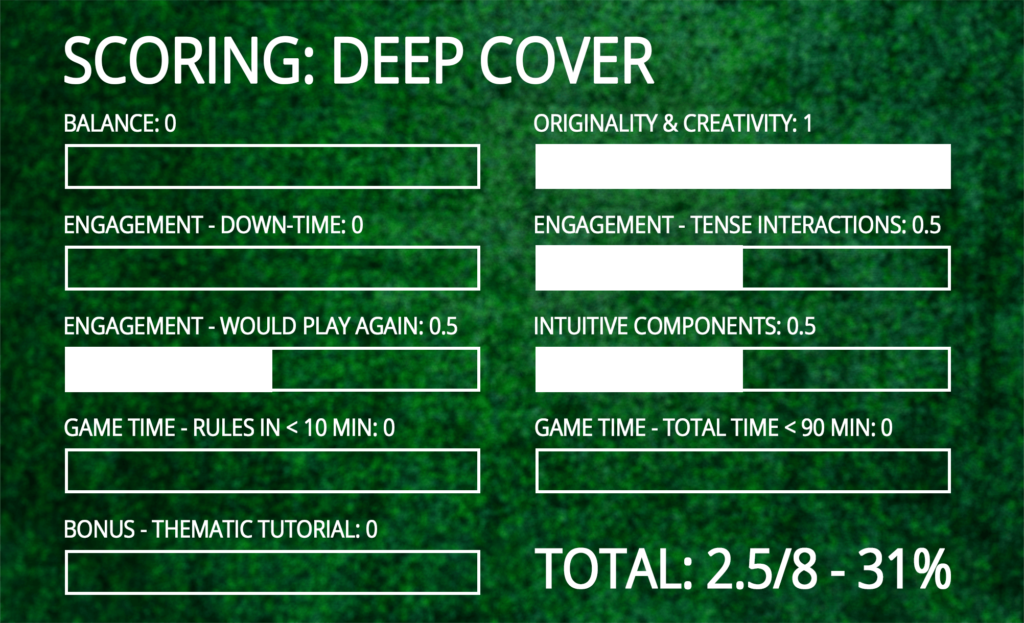
Balance: 0
From what I could tell based on my admitted lack of understanding of the rules, I could imagine many possible situations that seemed unfair to the traitors. As it stands, I would not feel good about getting assigned a traitor role in this game.
Originality & Creativity: 1
Everyone I showed this game to thought the idea of two teams, each with a traitor of their own, was a new and interesting idea. The theming is also very rich and creative. Even though I feel the current mechanics need a lot of refining, I think the concept would be worth the effort of developing further.
Engagement – Down-Time: 0
I can’t say with certainty that this game clips along and keeps all players continually engaged. I think if the designer implements some of my above suggestions, the turns could go quickly and down-time could be minimal. In the play through I did, all players were too confused about how they were supposed to play their cards for player turns to run smoothly. There was also a clear sense of impatience around the table when the one round we played resulted in no progress towards game completion.
Engagement – Tense Interactions: 0.5
The game setup definitely created a feeling of distrust around the table, which is a good sign. Unfortunately, the the confusion involved in the player interactions for our game was too overwhelming for the tension to come through in our individual interactions.
Engagement – Would Play Again: 0.5
Although I would not play the game as written again, I would be interested to play a future iteration. I still feel the concept is interesting and has the potential to be a great social deduction experience if the game could be streamlined and confusion eliminated.
Intuitive Components: 0.5
As mentioned in my components breakdown above, the lack of a rule book in the game box was inconvenient, the identity cards for the traitor roles were a little confusing, and the print describing the actions on the location cards should be a bit larger. Other than these issues, the user interfaces of the cards themselves were easy to use and understand.
Game Time – Rules in under 10 min: 0
We spent a lot of time passing around the rule book and trying to come to a consensus on how to play. The teach definitely did not go smoothly. Again, I think the rules concept could be easy to explain in 10 minutes once everything has been clarified and cleaned up.
Game Time – Total Time under 90 min: 0
As mentioned in my mechanics breakdown above, the end game condition of one team reaching 40 points feels unlikely to happen quickly. Since we weren’t able to finish the game, I don’t have solid data on how long it would take, but I’m not willing to give any points for a play time under 90 minutes if I can’t verify it.
Bonus – Thematic Tutorial: 0
The theme of this game was great, but there was no tutorial mode that used theme or story to help walk players through the process of learning how to play.
Total Score: 2.5/8 – 31%
You can see the scoring breakdown for all the semi-finalists and finalists in this game design challenge in my public scoring spreadsheet.
Scoring
Thank You to my Protospiel Madison Play Test Crew
Nyles Breecher, Steven Dast, Owen Lange, Ben Moy, and Will Newton
Leave a Reply